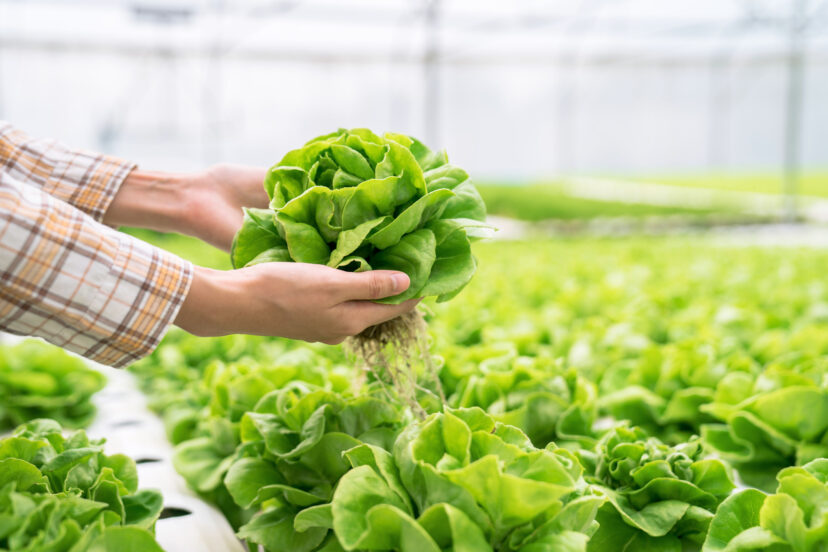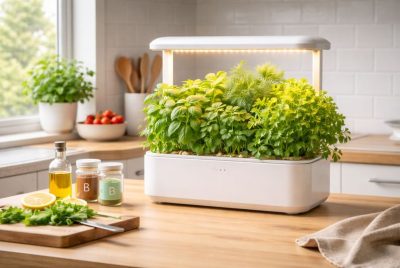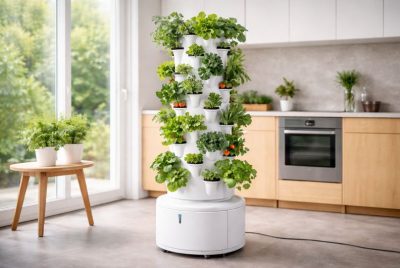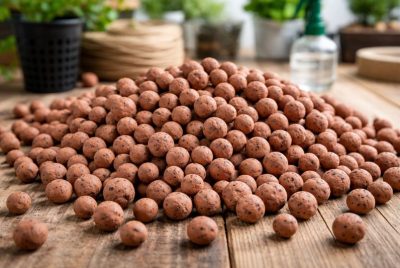Hydroponic Grow System: Guide to Growing Without Soil
We may earn a commission for purchases made using our links. Please see our disclosure for more details.
The first thing that comes to mind when you hear the word “Garden” is a sunlit patch of earthy soil with flourishing green plants (or flowers), right? Here’s the thing… what if we reimagine that garden and remove the soil in the picture? That right there is what we call “hydroponics”. A thriving garden without soil. In this guide, we’ll explore the hydroponic grow system and how it could change the way you nurture plants at home.
What is Hydroponics?
For newbies who don’t understand the meaning of hydroponics, hear me out. Hydroponics is a method of growing plants in water (enriched with vital nutrients) instead of soil. Here, plants get their food directly from a nutrient-rich water solution so they don’t need to dig in the dirt just to get what they need. Additionally, you have control over the plant’s environment so there’s a higher chance of yields. Oh, and hydroponics uses 90% less water, unlike soil gardening. The best part? Most hydroponic systems require less space so you can grow plants indoors or even at your apartment.
Why Choose Hydroponics Over Traditional Gardening?
If I were to choose between traditional gardening or hydroponics, I would probably choose the latter. Why? First of all, hydroponics requires less effort than soil gardening. After setting up the hydroponic system and all the seedlings were transferred, here’s what I need to do: check the water and pH levels and then wait for it to grow, ready for harvest. Plus, in this method, plants grow faster and often yield more. At the end of the day, you have a choice whether to dig in the dirt and carefully grow plants or just dive into hydroponics.
The Science Behind Hydroponics
Hydroponics is also backed by science and research. So here, plants are suspended in nutrient-rich water where both nutrients and oxygen are delivered right to their roots. Now what are the advantages of dipping their roots in water? Well, without soil, plants can devote all their energy to growth. It’s basically a system designed to make every drop of water and every molecule of nutrient count. Very sustainable!
Research underscores hydroponics as a sustainable solution for modern agriculture, with notable advantages in resource efficiency and adaptability. A review published by SpringerLink highlights hydroponics’ eco-friendly nature, emphasizing its reduced water use and minimized need for chemical fertilizers. Similarly, Frontiers in Plant Science provides an in-depth analysis of various hydroponic systems, such as the nutrient film technique (NFT) and aeroponics, outlining their impact on modern horticulture and their potential to support sustainable food production in diverse environments.
The Different Types of Hydroponic Systems
Intrigued by the options? Hydroponics isn’t one-size-fits-all; it’s a versatile approach with several unique systems to explore:
- Nutrient Film Technique (NFT): This system uses a gentle stream of water that flows continuously past the roots, ideal for smaller plants like herbs.
- Deep Water Culture (DWC): Here, plants float in water, their roots fully submerged in nutrient-rich solution, perfect for leafy greens.
- Ebb and Flow (Flood and Drain): Water rises to cover the roots then drains away, cycling throughout the day.
- Aeroponics: Plants hang in the air, with roots periodically misted with nutrients—ultra-efficient for smaller spaces.
- Wick System: Nutrients are pulled up to the roots via a wick, offering a low-maintenance, beginner-friendly option.
Each of these systems has its own set of perks, allowing you to customize your setup to fit your plant’s needs and your available space. Which one matches your needs?
What Can You Grow in a Hydroponic System?
Ready to start your hydroponic grow system journey? Good!!! If you’re wondering which plants to grow, I got you covered. Hydroponics is excellent for leafy greens (like lettuce which was my first option back then), herbs, and certain fruits (like strawberries). Let’s put it this way… if a plant doesn’t require deep roots, it’s likely a good candidate for hydroponics. Just a reminder, do your homework and learn how to grow the plant of your choice so you can decide if you can handle it.
Benefits of Hydroponic Growing
Why take the plunge? Here are some reasons that make hydroponics a tempting choice:
- Faster Growth: Plants can grow up to 30-50% faster than in soil.
- Space Efficiency: You can stack plants vertically, perfect for smaller spaces.
- Water Efficiency: Hydroponics can save as much as 90% more water compared to traditional soil gardening.
- Fewer Pests and Diseases: Without soil, many common pests and diseases are eliminated.
- Year-Round Growing: Hydroponics allows indoor growing regardless of outdoor conditions.
Challenges of Hydroponic Gardening
It’s not all a bed of roses, of course. Here are a few challenges to be mindful of:
- Initial Setup Costs: While incredibly rewarding, setting up a hydroponic system isn’t cheap.
- Learning Curve: There’s an art to balancing nutrients that may take time to master.
- Electricity Dependence: Many systems rely on pumps and lights, so power outages can be risky.
Setting Up Your First Hydroponic System
Ready to dive in? Here’s how to set up your hydroponic haven:
- Choose Your System Type: Decide whether DWC, NFT, or another type fits your plant choice best.
- Find a Space: Any room with stable temperatures will work, even a basement or spare room.
- Gather Equipment: You’ll need basics like a grow tray, water pump, air pump, reservoir, growing medium, and nutrient solution.
- Assemble the System: Ensure the water flow and aeration suit your chosen system.
- Add Lighting: LED grow lights work wonders, especially if you’re indoors.
- Mix Nutrients Carefully: Following a nutrient guide will help you balance the mix.
Recommended Products for Hydroponic Grow Systems
- Hydroponic System Kit
- AeroGarden Harvest Indoor Garden: This compact, easy-to-use system is perfect for beginners looking to grow herbs and small vegetables. It includes an automatic LED grow light and a built-in water reservoir, making it virtually maintenance-free and ideal for indoor growing.
- Grow Light
- Spider Farmer SF Series: Known for its energy efficiency and high light output, this full-spectrum LED grow light promotes optimal growth for hydroponic plants. It distributes light evenly, reduces hotspots, and operates with low heat, making it safe for indoor use.
- Nutrient Solution
- General Hydroponics Flora Series: This three-part nutrient system includes Grow, Micro, and Bloom formulas, allowing precise control over nutrient levels at each growth stage. It’s widely trusted in hydroponics for providing a balanced nutrient profile to support vigorous plant growth.
- pH Testing and Maintenance Tool
- Apera Instruments pH Tester: Designed for accuracy and ease of use, this pH tester helps maintain the perfect pH balance for nutrient solutions. It’s durable, waterproof, and provides reliable readings, essential for optimal hydroponic plant health.
- Growing Medium
- Clay Pebbles (LECA): Lightweight and reusable, clay pebbles provide excellent drainage and aeration for roots, making them ideal for hydroponic systems. Their neutral pH and stability prevent nutrient imbalance, creating a supportive environment for plant growth.
Hydroponic Growing Media Explained
Without soil, plants still need support, which is where growing media come into play. Here are a few options:
- Rockwool: A moisture-retentive fiber-based medium.
- Coco Coir: Sustainable and water-retentive, made from coconut husks.
- Perlite and Vermiculite: Lightweight minerals that aid in water retention.
- Clay Pebbles: Reusable, lightweight, and great for larger plants.
Choosing the right medium helps ensure your plants’ roots have the stability they need to thrive.
Nutrient Solutions: The Heart of Hydroponics
Ah, the nutrient solution… it’s literally the heart of hydroponics! Wondering why? Well, without it, your plants can’t thrive and it’s not hydroponics at all. Each plant type benefits from a unique blend of nitrogen, phosphorus, potassium, and other minerals. Some gardeners create their own mix, adjusting nutrients as plants mature. But be careful and follow the recommended mix if you’re a beginner to avoid root rots. As you gain experience, you can create your own mix too.

How to Maintain Your Hydroponic System
Maintenance is simple but essential. Here’s a quick routine:
- Check pH Levels: Hydroponic plants prefer a pH range of 5.5-6.5.
- Monitor Water Levels: Always ensure water is readily available to the roots.
- Clean the System: Every few weeks, clean algae or any buildup.
- Inspect Plants Regularly: Look out for any signs of nutrient deficiencies or problems with root health.
Lighting: The Key to Indoor Hydroponics
Who says hydroponics needs water only? Nah, plants need some light too! If you’re growing outdoors, then you don’t need to worry about sunlight. But if you’re growing indoors (where access to natural light is limited) then LED grow lights are your best option. To mimic sunlight, aim for 12-16 hours of light per day, which will help your plants flourish.
Hydroponics and Climate Control
Hydroponics thrives in a carefully regulated environment. “What do you mean regulated environment?” Well, things like air temperature, humidity, light, nutrient solution, and even the carbon dioxide concentration in the air must be in check. Aim for temperatures between 65-75°F (18-24°C). Managing humidity and temperature will promote lush and healthy growth. Don’t worry, small heaters or fans can do the trick.
Hydroponics and Sustainability
Talking about sustainability, hydroponics is very sustainable. How? It uses less water since the nutrient solution only flows to the roots and is recycled through a water pump. Also, hydroponics don’t need many pesticides. The best part??? It has a potential for urban cultivation. This approach could help reduce the environmental impact of food production. Imagine harvesting fresh, organic herbs in your kitchen—no farm trucks, no extra carbon footprint. Tastes even better!
Common Mistakes and How to Avoid Them
To avoid common pitfalls, keep these in mind:
- Overfeeding Nutrients: More isn’t always better, as too many nutrients can actually harm plants.
- Ignoring pH Levels: Imbalanced pH may lock out nutrients.
- Poor Air Circulation: Stagnant air encourages mold.
- Neglecting Root Health: Keep an eye out for root rot or discoloration.
Is Hydroponic Gardening Right for You?
Honestly, if you want a garden but are too lazy for dirt digging, then this one’s for you. Short in space? This is for you as well. Want fresh produce indoors? Try hydroponics. Of course, hydroponic grow system does require attention to detail and budget, but for many, it’s a journey worth the time and care.
Tips for Successful Hydroponic Gardening
Looking to master hydroponics? Here’s some wisdom to get you started:
- Start Small: Begin with easy plants like lettuce or basil.
- Stay Consistent: Regularly check your nutrient mix, pH, and lighting.
- Document Progress: Note what works and what doesn’t for future reference.
- Expand Slowly: Experiment gradually as you get comfortable.
- Have Patience: Hydroponics has a learning curve, but it’s incredibly rewarding.
Conclusion
Hydroponics might be the future of gardening because of its sustainability and ability to grow healthier plants faster with higher yields. If you’re looking for a way to grow lettuce but don’t have the space and time, then hydroponics might be your best option. Sure, it does require attention to detail and money but the benefits make it all worth it. Ready to start your hydroponic grow system journey?
5 FAQs About Hydroponic Grow Systems
- What’s the best hydroponic system for beginners?
- Try Deep Water Culture (DWC). It’s simple, affordable, and beginner-friendly.
- Can I grow any plant hydroponically?
- Sure but leafy greens like lettuce and herbs do well. Root-heavy plants aren’t ideal.
- Do hydroponic plants taste different?
- In my experience, the flavors are just as good, if not better!
- How much electricity do hydroponic systems use?
- It depends on how big your setup is but LED lights and small pumps are energy-efficient, so expect a minor increase in electricity costs.
- Is hydroponic gardening sustainable?
- Yes! It conserves water, reduces pesticide use, and supports urban growth.




